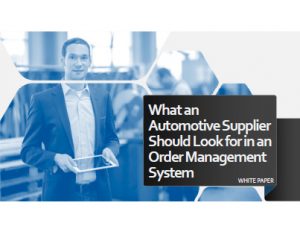What to Look for in an Automotive Order Management System
In the automotive world, an efficient order management system is a must-have to streamline how suppliers respond to customer requirements and coordinate orders. It must be full-featured, easy-to-use, and frequently updated with the most recent data from OEM customers.
At the foundation of an automotive order management system is a well-designed and logical electronic data interchange solution. Automotive EDI software solutions share electronic data seamlessly between automotive suppliers and their OEM and Tier customers, coordinating orders throughout the supply chain. Must-have features deliver accuracy, faster order and transaction processing, and cost savings.
Critical Order Management System Features
What are the most critical features of an effective order management system? World-class order management is built on a supply chain management solution with a solid EDI logical framework that incorporates trading partner – OEM and sub‐tier – business requirements. It gives suppliers an efficient demand production schedule and offers EDI transactions for all of the trading partners, including FCA, Ford, GM, Honda, Toyota, other OEMs, and hundreds of Tier I and Tier II automotive suppliers.
The best systems:
- Handle multiple types of orders in a centralized system
- Remove the headache of having to map customer data
- Support different EDI standards to meet customer requirements (X.12, UN/EDIFACT, Odette, VDA, and flat file) and allow customers to change their EDI standards (e.g., from X.12 to UN/EDIFACT)
- Quickly manage customer changes to EDI processes and labels
- Integrate EDI into an ERP order system, without manual rekeying of requirements
- Automate the tracking of customer requirements, including special reference information such as kanbans, Release Authorization Numbers (RAN), manifest numbers, ship order numbers, line feeds, dock codes, handling codes, and pack information
- Track specific details from inbound EDI to be included on outbound EDI on an order-by-order basis
- Manage the unique automotive cumulative or CUM accounting, including:
- Prior CUM required – cumulative amount required prior to the new release schedules
- Supplier CUM shipped – total cumulative amount shipped for a given period
- Customer CUM received – total cumulative amount received for a given period
- Coordinate customer and supplier CUM accounting and calculate net requirements due
- Trigger automated alerts to notify parties of changes to requirements or other critical information following set parameters, for example, for EDI release net changes, EDI-to-orders update exceptions, selling price changes, and changes in requirements affecting current shippers
- Coordinate non-EDI orders
- Manage selling price changes with an array of reports and utilities
- Track parts in the automotive Pre‐Production Part Approval Process (PPAP) to make sure parts meet specific quality requirements
- Guide shipping for suppliers, coordinating transit days, days to cover, shipment‐based rather than transit day‐based requirements, valid shipping days for material to be shipped, and late pick‐up times from carriers
- Offer standard pack logic, destination‐level and order‐level control of bar code label format definitions, freight management/consolidation, shipments to and from consignment warehouses, returnable container tracking, and more
- Accommodate international shipping within a multi-currency, global marketplace
Gain greater insight and full details about world-class order management in our white paper: What an Automotive Supplier Should Look for in an Order Management System.
The Benefits of a World-Class Order Management System
When a world-class order management system is fully integrated with a modern ERP order solution, users gain critical benefits. An automated system built on an expansive EDI foundation with a logical framework means suppliers can respond quickly to customer requirements, meeting deadlines and fulfilling customer compliance demands. An automated system gives users visibility into all phases of the order process, with full traceability and robust report functions.
Customer satisfaction is paramount in the automotive industry. A well-designed and up-to-date order management system gives suppliers flexibility to respond to changing customer needs. The results? A positive and productive customer experience. At the same time, a modern, automated order management system decreases administrative costs by streamlining order processing and shipping functions.
A flexible and efficient order management system gives customers the trust that risk is being reduced and the possibility of late or mislabeled orders is significantly decreased.




